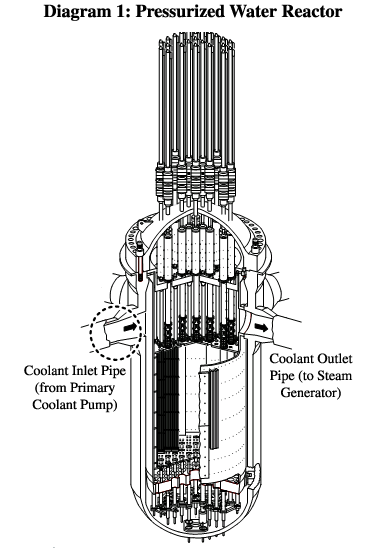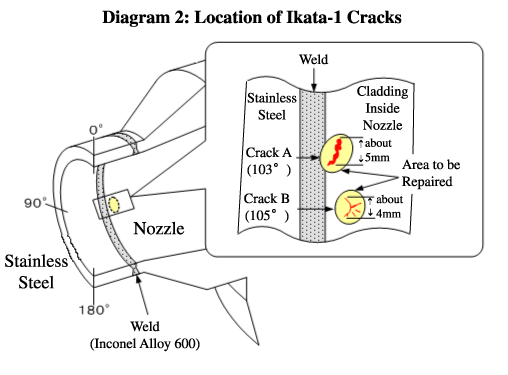This article begins with a follow-up on the report in NIT 101 about cracks in the Ohi-3 (PWR, 1,180 MW) reactor vessel head, then reports on the cracks that were discovered later in the primary coolant inlet pipe nozzle on the reactor vessel at Ikata-1 (PWR, 566 MW).
Ohi-3
On October 19 Kansai Electric Power Company (KEPCO) announced its response to the cracks in the Ohi-3 reactor head. KEPCO concluded that at the time of manufacture the post-weld treatment of the welds of the control rod drive mechanism was inadequate and that this led to stress corrosion cracking. It has decided to replace the head during the periodic inspection beginning in September 2006. In the meantime, as a stopgap measure, it decided to weld over the inner side of the cracks and attach a moisture monitor to detect any leaks. This it swiftly did and restarted the reactor on January 11, with the cracks still there.
Ikata-1
 Around one month after the Ohi-3 response was announced, on November 14, Shikoku Electric Power Company announced that cracks had been discovered in the primary coolant inlet pipe nozzle on the reactor vessel at Ikata-1. The cracks were found in one of two nozzles (nozzle B), where the primary coolant re-enters the reactor vessel, after returning from the steam generator.
Around one month after the Ohi-3 response was announced, on November 14, Shikoku Electric Power Company announced that cracks had been discovered in the primary coolant inlet pipe nozzle on the reactor vessel at Ikata-1. The cracks were found in one of two nozzles (nozzle B), where the primary coolant re-enters the reactor vessel, after returning from the steam generator.
Ikata-1 has been undergoing a periodic inspection since September 5 and is expected to be out of operation for a total of five months. During that time, in preparation for loading Step II high burn-up fuel (refer NIT 102 News Watch), major work will be done including the following: the core barrel will be replaced, extra control rods will be added, a boric acid concentration tank will be added. In addition, stainless steel pipes in such areas as the primary coolant residual heat removal system will be replaced and measures are planned to deal with stress corrosion cracking of Inconel Alloy 600 (a nickel-based alloy) welds in areas such as the reactor vessel nozzles.
At the time of the announcement, Shikoku Electric was preparing to apply laser treatment to relieve residual stress around welds of reactor vessel inlet nozzles. The cracks were found in Inconel Alloy 600 welds joining a stainless steel pipe to a carbon steel nozzle with an outer diameter of 90cm and a thickness of 8cm. There is cladding inside the nozzle and the cracks were found at the point where the stainless steel pipe was welded to this cladding. Two cracks, 5mm and 4mm long, were found.

According to a November 22 announcement by Shikoku Electric, an inspection involving grinding the area showed that the cracks were 3mm deep at the deepest point, but they didn't penetrate through the 5mm thick cladding to the nozzle itself. It could be seen that the welds where these two cracks were located had been touched up after the original welding. Inconel Alloy 600 had been used for this. It would seem that there is a high probability that the cracks are stress corrosion cracks caused by residual stress from this touch-up welding. It is easy to imagine that problems might have arisen in the original welding, but the reason for the welding repairs carried out at the time remains unclear.
On December 1 Shikoku Electric announced the method by which they intend to repair the welds. They will weld over the cracks using Inconel Alloy 690, which is thought to be comparatively resistant to stress corrosion cracking.
Given that the cracks were found in the reactor's Primary Coolant Inlet, even if they were small they should not be treated lightly, because the cracking could have progressed and led to a major leak of primary coolant. After the measures announced by Shikoku Electric are carried out, the cracks will still remain, so it can hardly be called an adequate response.

